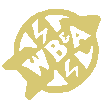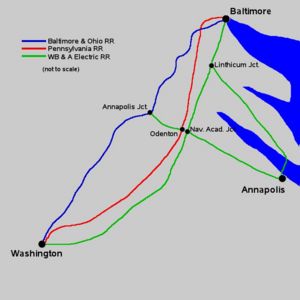Washington, Baltimore and Annapolis Electric Railway
| Washington, Baltimore and Annapolis Electric Railway | |
|---|---|

| |
 WB&A System map | |
| Locale | Maryland and Washington, D.C. |
| Dates of operation | 1908 – 1935 |
| Successor line | abandoned |
| Track gauge | 4 ft 8½ in (1435 mm) |
| Headquarters | Annapolis, Maryland |
The Washington, Baltimore and Annapolis Electric Railway (WB&A), now defunct, was an American railroad of central Maryland and Washington, D.C., built in the 19th and 20th century. The WB&A absorbed two older railroads, the Annapolis and Elk Ridge Railroad and the Baltimore and Annapolis Short Line, and added its own electric streetcar line between Baltimore and Washington, D.C. It was built by a group of Cleveland, Ohio, electric railway entrepreneurs to serve as a high-speed, showpiece line using the most advanced technology of the time.[1] It served Washington, D.C.; Baltimore and Annapolis, Maryland, for 27 years, but the Great Depression and the rise of the automobile marked the end of the WB&A. Passenger service ceased in 1935 and only the Baltimore & Annapolis portion continued to operate. Parts of the right-of-way are now used for light rail, rail trails and roads.
Contents
History
Origins
The WB&A was originally incorporated in 1888 as the Potomac and Severn Electric Railway. On April 10, 1900, it changed its name to the Washington and Annapolis Electric Railway[2] and finally, on April 8, 1902, to the Washington, Baltimore and Annapolis Electric Railway.[3] In 1903 the WB&A purchased the Annapolis, Washington & Baltimore Railroad (AW&B) - formerly the Annapolis & Elkridge Railroad - which was closed, electrified and reopened.[4] At the same time an almost straight double-track route was laid out parallel to the B&O and Pennsylvania railroads, but located slightly to the east in less populated territory. On February 7, 1908, service began running from Liberty Street in Baltimore to its terminal at 15th and H Streets NE in Washington.[5]. After 1910 the line reached the heart of downtown on 15th Street near the Treasury.[5] Additional single-track service ran from Annapolis Junction on the B&O, crossed the WB&A main line at a spot just east of Odenton, and headed east to Annapolis via Millersville and Crownsville.[1]
The line built by the WB&A, later called the Main Line, ran from Baltimore to Odenton through Bowie, Glenn Dale Hospital, and Glenarden to Fairmont Heights where it met with the Chesapeake Beach Railroad just outside the Washington, D.C., line at Chesapeake Junction. From there, it continued to Deanwood on tracks running parallel to the Chesapeake Beach Railroad tracks and then across the Benning Road Bridge on existing streetcar tracks into Washington. It was the main source of transportation to Suburban Gardens, known as "the black Glen Echo", the first and only major amusement park within Washington.
Once onto their own right-of-way, the WB&A's expresses regularly hit 60 mph, but street running in the terminal cities slowed their overall time. A typical B&O express made the trip in 50 minutes, but the best the WB&A could do was an hour and 20 minutes. Offsetting these handicaps were its cleanliness, lower fares, half-hourly express service, and better-located downtown terminals.[1]
Business Along the Route
Always looking for new sources of business, the railroad, in 1914, convinced the Southern Maryland Agricultural Fair Association to establish Bowie Race Track along the Main Line.[1]
In September 1917, as the U.S. entered World War I, George Bishop, the WB&A’s well-connected president, persuaded the U.S. Army to acquire land owned by the railroad and open a training facility. Camp Meade was established in the area roughly bounded by the B&O Washington Branch on the west, the Pennsylvania Railroad on the east and the South Shore Line of the WB&A to the south. The installation was supposed to be a temporary facility, used only for the duration of the war (it is still in use today). The WB&A saw record traffic during this time as a result of freight and passenger service to the camp. In 1918, the railroad was running as many as 84 special trains a day.[1]
Expansion
With the business seemingly successful the WB&A purchased the Baltimore and Annapolis Short Line in 1921.[1] It became known as the North Shore Line and the Annapolis to Odenton line as the South Shore Line. At this time, the B&A gave up the terminus at Camden Station and started using the WB&A terminal on Liberty Street (between Lexington and Fayette) in Baltimore. Prior to 1921 the WB&A and B&A had run on separate, parallel tracks from Linthicum to Baltimore. But on March 16, 1921, a crossover connected the two parallel tracks at Linthicum, operations ceased on the B&O track, and a new terminal was built at Howard and Lombard Streets.[6] The WB&A now consisted of 81 miles of track and the only practical way to get from Washington, D.C., to Annapolis.
Decline
Around the time of the purchase of the ASL, the Defense Highway was built providing an alternative route into Annapolis.[1] As a result gross receipts for the railroad began to decline. The railroad only survived because of a law exempting it from taxes. In January 1931, during the Great Depression, the extension of the law failed to pass by one vote and the line went into receivership.[7] The line remained in operation for four more years until operation officially ceased on August 20 1935.[8] The WB&A was sold at public auction with scrap dealers buying most of the rolling stock. The right of way of the North Shore Line and some equipment was bought by the Bondholders Protective Society who then formed the Baltimore and Annapolis Railroad Company. Over time, the rails were hauled away, though by the beginning of World War II some remained and at least one post-War home in the area used old rails in lieu of I-beams.
The right of way within Washington, D.C. came under the ownership of Capitol Transit Company.[9] At some point after 1945 the tracks in DC were removed.
Stations on the Main Line
- Baltimore
- Westport
- English Consul
- Rosemont
- Baltimore Highlands
- Pumphrey
- North Linthicum
- Linthicum
- Downs
- Wellham
- Kelly
- McPherson (WB&A Rd)
- Elmhurst
- Delmont
- Clark
- Severn Run
- Naval Academy Junction
- Waugh Chapel (Waugh Chapel Rd)
- Francis
- Bragers (Bragers Rd)
- Conway (Conway Rd)
- Meyers (Meyers Station Rd)
- Bowie
- LLoyd
- High Bridge
- Hillmeade
- Bell
- Randle
- Lincoln
- Vista
- Cherry Grove
- McCarthy
- Ardmore
- Glenarden
- Dodge Park
- East Columbia Park
- Huntsville
- Gregory
- District Line where the WB&A entered Washington, D.C., and the trains transferred to tracks interior to the city line.
Surviving Landmarks
- The WB&A Terminal in Baltimore, now a bank at North Liberty Street & Marion Street
- The Scott Street substation on the NE corner of Scott & Ostend Streets
- The Westport tunnel, its southern portal is visible just north of the B-W Parkway's Annapolis Road exit.
- The Hunt Valley-Glen Burnie line of Baltimore's light rail system uses the rail's right-of-way from Baltimore Highlands through North Linthicum to a point north of Maple Road and again from south of Linthicum to BWI Airport (at other times it uses the Baltimore & Annapolis Railroad's parallel right-of-way).
- Linthicum railroad station.
- WB&A Boulvard in Severn was built on the right-of-way.
- Both the portion of the WB&A Trail in and around Odenton and the 5.5-mile section of the same trail from Bowie to Glenn Dale run on the old right-of-way of the Main Line. Anne Arundel County plans to connect those trails in the next few years.
- Martin Luther King Jr. Highway was built on the right-of-way.
See also
- Stations on the South Shore Line
- Stations on the North Shore Line
References
- ↑ 1.0 1.1 1.2 1.3 1.4 1.5 1.6 Herbert H. Harwood Jr. (2004-2005). Washington, Baltimore & Annapolis Electric Railroad. Retrieved on 2006-10-26.
- ↑ Laws of the 1900 Maryland General Assembly Session (1900). Retrieved on 2006-10-23.
- ↑ Laws of the 1902 Maryland General Assembly Session (1902). Retrieved on 2006-10-23.
- ↑ Herbert H. Harwood Jr. (2004-2005). Annapolis & Elk Ridge Railroad. Retrieved on 2006-10-12.
- ↑ 5.0 5.1 Richard Layman (February 2003). H St: A Neighborhood's Story Part II. Retrieved on 2006-12-11.
- ↑ Herbert H. Harwood Jr. (2004-2005). Baltimore & Annapolis Railroad. Retrieved on 2006-11-08.
- ↑ Williams v. Mayor and City Council OF Baltimore, 289 U.S. 36 (1933) (March 1933). Retrieved on 2006-10-23.
- ↑ Washington Baltimore & Annapolis Electric Ry.. Retrieved on 2006-11-09.
- ↑ USGS 7.5 Minute Series map of Washington East, MD Quadrangle (1945). Retrieved on 2006-11-21.
- Merriken, John E. (1993). Every Hour On The Hour; A Chronicle of the Washington, Baltimore & Annapolis Electric Railroad. Taylor Publishing Company. ISBN 0-9600938-3-4.
